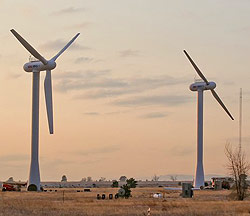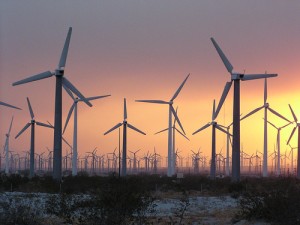July 1, 2014 – With 2014 half gone I ask this question – why do wind turbines have three blades? Don’t ask me why I ask this question? It came to me about a week ago and then when I read an article from the MIT Technology Review it seemed like an appropriate topic to write about.
Conventional wind turbine design these days is three blades, not four, five or two. Physics states that three blades are more efficient than four because the turbulence from the more blades you add the less efficient the air flow. With three they are far enough from each other to minimize turbulence. Add a fourth and you decrease separation reducing the net energy yield from each blade. And although a four-bladed wind turbine produces a little more net energy than three blades, the extra cost of manufacturing yields little in return on investment.
Some argue that three blades is aesthetically perfect and ideal for a balanced load on the supporting mast. I would challenge the statement on aesthetics. Wind farms look like giant aliens striding across the landscape. Look at the one depicted below. I can’t help but think of Don Quixote and Sancho Panza riding out to challenge these monster towers of power. And look, they are all three-bladed.
But what if we manufactured a wind turbine with two blades? And what if we turned the blades around to face downwind? Would we lose energy efficiency? Apparently not according to several companies manufacturing wind turbines these days. A two-bladed wind turbine would be cheaper to build and install. And the manufacturers state there would be no drop off in energy generating capacity.
To prove this a number of companies are in the process of demonstrating two-bladed downwind turbines. In China, a 6 Megawatt two-bladed downwind-designed wind turbine is currently under construction. The Chinese are also erecting a similar wind turbine in Norway. Joining China are Hitachi, Fuji, and 2-B Energy, the latter a Dutch company.
Three-bladed wind turbines face upwind. The blades are designed to withstand bending in the face of the wind. To achieve this the manufactures increase tensile strength and weight in every wind turbine structure. With two-blades, however, the wind turbine is lighter. The rotor at the centre, is not as heavy. A lighter rotor can be put in a downwind position. And the overall weight reduction makes each tower a lot less expensive to build.
In the past two-bladed wind turbine designs were deemed too noisy. Utility companies, therefore, considered them solely for offshore wind farms. Two-bladed designs were known to spin faster posing an additional risk – the potential for the blades to snap in high wind conditions. Recent new rotor designs with on board braking systems that compensate for higher wind conditions, however, have suddenly made two-blades more attractive. And when you add the fact that two-bladed wind turbines require less material and can be built in a variety of sizes suitable to standalone and micro-grid configurations, manufacturers have good reasons to consider them as an alternative to conventional three-bladed technology. In the image below you can see a field test between two and three-bladed wind turbines. Results show no appreciable difference in energy output.
So I suspect we will see two-blades appear in many wind turbine installations over the coming years. The lower cost alone should make the energy they produce cost competitive with non-renewable power sources.














I have wondered why odd numbered items are more aesthetically pleasing than even numbers. It certainly is in design, it’s called the ‘Rule of Odds’, for example check car wheel spokes and the composition of art http://en.wikipedia.org/wiki/Composition_%28visual_arts%29.
I do hope the two bladed wind turbines work well but I would miss the three bladed ones.
[…] Why do Wind Turbines Have Three Blades? Maybe They Shouldn’t […]